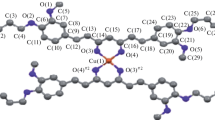Abstract
A curcumin derivative ligand, 1,7-bis(3-methoxyl-4-acetoxyl)phenyl-1,6-heptadiene-3,5-diketone (diacetylcurcumin, abbreviated as HL), and its Cu and Ni complexes have been synthesized and fully characterized by elemental analyses, IR, 1HNMR and molar conductivity. The resulting complexes exhibit two-photon excited fluorescence (TPEF) in DMF, and have been proven to be potentially useful for two-photon microscopy imaging in living cells. In addition, cytotoxicity tests showed that the low-micromolar concentrations of ML2 did not cause significant reduction in cell viability over a period of at least 24 h and should be safe for further biological studies.
Similar content being viewed by others
References
Johnson JR, Fu N, Arunkumar E, Leevy WM, Gammon ST, David PW, Smith BD. Squaraine rotaxanes: Superior substitutes for Cy-5 in molecular probes for near-infrared fluorescence cell imaging. Angew Chem Int Ed, 2007; 46: 5528–5531
Kim HM, Cho BR. Two-photon probes for intracellular free metal ions, acidic vesicles, and lipid rafts in live. Acc Chem Res, 2009; 42(7): 863–872
Barker N, van Es JH, Kuipers J. Identification of stem cells in small intestine and colon by marker gene Lgr5. Nature, 2007; 449: 1003–1007
Cahalan MD, Parker I, Wei SH, Miller MJ. Two-photon tissue imaging: seeing the immune system in a fresh light. Nat Rev Immunol, 2002; 2: 872–880
Caldwell CM, Green RA, Kaplan KB. APCmutations lead to cytokinetic failures in vitro and tetraploid genotypes inMin mice. J Cell Biol, 2007; 178: 1109–1120
Lee JH, Lim CS, Tian YS, Han JH, Cho BR. A two-photon fluorescent probe for thiols in live cells and tissues. J Am Chem Soc, 2010; 132: 1216–1217
Quentmeier F, Quentmeier CC, Walla PJ, Gericke KH. Two-color two-photon excitation of intrinsic protein fluorescence: Label-free observation of proteolytic digestion of bovine serum albumin. ChemPhysChem, 2009; 10: 1607–1613
Li L, Tian YP, Yang JX, Sun PP, Wu JY, Zhou HP. Facile synthesis and systematic investigations of a series of novel bent-shaped two-photon absorption chromophores based on pyrimidine. Chem Asian J, 2009; 4: 668–680
Gao YH, Wu JY, Li YM, Sun PP, Zhou HP, Yang JX, Zhang SY, Jin BK, Tian YP. A sulfur-terminal Zn(II) complex and its two-photon microscopy biological imaging application. J Am Chem Soc, 2009; 131: 5208–5213
Zhou SS, Zhang Q, Hao FY, Wu JY, Tian YP. Synthesis, crystal structure, optical properties, dna-binding and cell imaging of an organic chromophore. Dyes and Pigments, 2011; 92: 689–695
Zhou SS, Zhang QY, Qin K, Lu CH. Synthesis and antitumor activities of triazacyclodecane and its platinum complex. Acta Pharm Sin, 2008; 43 (5): 490–494
Xiao LX, Luo YM, Chen Z, Li J, Tang RR. Investigations into the synthesis and fluorescence properties of Tb(III) complexes of a novel bis-diketone-type ligand and a novel bispyrazole ligand. Spectrochimica Acta Part A, 2008; 71: 321–325
Vigato PA, Peruzzo V, Tamburini S. The evolution of β-diketone or β-diketophenol ligands and related complexes. Coord Chem Rev, 2009; 253: 1099–1201
Zhang JC, Gon YQ, Zheng XM. Synthesis and antitumor of Iodine bridge binuclear platinum complexes. Chin Sci Bull, 2006; 51 (7): 796–801
Geary WJ. The use of conductivity measurements in organic solvents for the characterisation of coordination compounds. Coord Chem Rev, 1971; 7: 81–122
Tian YP, Li L, Zhang JZ, Yang JX, Zhou HP, Wu JY. Investigations and facile synthesis of a series of novel multi-functional two-photon absorption materials. J Mater Chem, 2007; 17: 3646–3654
Lakowicz JR. Principles of Fluorescence Spectroscopy. New York: Plenum Press, 1983; 190
Zbigniew R, Grabowski KR, Wolfgang R. Structural changes accompanying intramolecular electron transfer: Focus on twisted intramolecular charge-transfer states and structures. Chem Rev, 2003; 103: 3899–4031
Qian Y, Meng K, Lu CG, Lin BP, Huang W, Cui YP. The synthesis, photophysical properties and two-photon absorption of triphenylamine multipolar chromophores. Dyes and Pigments, 2009; 80: 174–180
Hao FY, Zhang XJ, Tian YP, Zhou HP, Li L, Wu JY, Zhang SY, Yang JX, Jin BK, Tao XT, Zhou GY, Jiang MH. Design, crystal structures and enhanced frequency-upconverted lasing efficiencies of a new series of dyes from hybrid of inorganic polymers and organic chromophores. J Mater Chem, 2009; 19: 9163–9169
Author information
Authors and Affiliations
Corresponding author
Rights and permissions
About this article
Cite this article
Zhou, S., Xue, X., Jiang, B. et al. Metal complexes of a novel bis-β-diketone-type ligand and its copper(II) complexes of two-photon biological imaging. Sci. China Chem. 55, 334–340 (2012). https://doi.org/10.1007/s11426-011-4470-0
Received:
Accepted:
Published:
Issue Date:
DOI: https://doi.org/10.1007/s11426-011-4470-0




